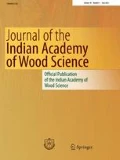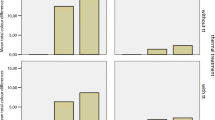Abstract
A number of recyclable bio-materials are available in India which can be used as raw material base for production of alternate products to wood and wood composites. Bamboo has emerged as a single largest material from which almost all products can be made as is usually made from timber. Perhaps the future generation will use more bamboo based materials due to their availability and versatility than wood and wood products. Besides bamboo, huge quantity of agro and forest residues are available every year in the country. A number of useful products have been developed from rice husk, coconut husk (coir), cotton stalk, bagasse and pine needle. Products made from coir, bamboo, cotton stalk and bagasse are already commercialized in India.
Similar content being viewed by others
References
Adkoli NS (1994) Bamboo in the Indian Pulp Industry. Paper presented in the IV International Bamboo Workshop, Chiangmai, pp 44–52
Anonymous (1966) Bagasse products ltd watford, new particle board from crushed sugar cane fibre. Board manuf 9(10):172–173
Anonymous (2002) Development of laboratory Scale Particle Board from Chir Pine Needle. IPIRTI Technical Report, pp 26–27
Ganapathy PM (1998) Development of wood substitute in India- prospects and constraints, proceeding of seminar on plantation timbers and bamboo IPIRTI. Bangalore, pp 74–82
Ganapathy PM, Zhu Huan Ming, Zoolagud SS, Turcke D and Espiloy ZB (1997) A state of the art review of bamboo board panels. International Network for Bamboo and Rattan, pp 85–89
George J (1968) Production of particle board from coconut husk. Indian J Gastroenterol 19(2):15–18
Guha SRD, Singh MM, Sharma YK, Kumar K (1979) Utilization of cotton stem and cotton wastes. Indian For 105(1):57–67
ICFRE (1995) Forestry statistics india 1995. Dehra Dun, pp 101–104
Lakshmana AC (1994) Culm production of Bambusa arundinacea in natural forests of Karnataka, India. In: Bamboo in Asia and the Pacific. Proceedings of the 4th international bamboo workshop, Chiangmai, Thailand, 27–30 November 1991. International Development Research Centre, Ottawa, Canada; Forestry Research Support Programme for Asia and the Pacific, Bangkok, Thailand, pp 100–103
Rai SN and Chakrabarti SK (1996) Demand and supply of fuel wood, timber and fodder in India. Forest Survey of India, Dehra Dun, pp 58–62
Singh RV (1994) Grazing and management in the forests of India. New Delhi, pp 145–147
Tewari DN (1992) A monograph on bamboo. International Book Distributors, Dehra Dun, pp 10–12
Ulbricht HJ (1957) The possibility of using bagassse and straw as raw material for particle board manufacture. Fibre board and particle board FAO/ECE/board, pp 17–19
Acknowledgments
This paper is published with the permission of Director, IPIRTI, Bangalore.
Author information
Authors and Affiliations
Corresponding author
Rights and permissions
About this article
Cite this article
Nath, S.K., Chawla, V.K. Wood substitution: recent developments in India. J Indian Acad Wood Sci 8, 68–71 (2011). https://doi.org/10.1007/s13196-012-0051-x
Received:
Accepted:
Published:
Issue Date:
DOI: https://doi.org/10.1007/s13196-012-0051-x




